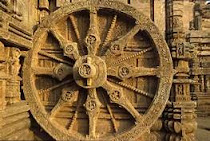The sketch of Hindu race is made in the way
that it only talked at large about the suffering and liberation and therefore
the soil germinated with cynicism and therefore the race went down and ruled by
many and many dynasties who invaded their land. But this is not the case
because Havel found in Aryan rule in India,
“The Vedas represent culture of
race of warriors, poets and philosophers who despised the art of coerce and
live mostly by agriculture.”
And for Hindus, philosophy, a darshan,
an insight for the right view bringing out the best way of living, both
socially and politically and ancient India shows that there was rise in
culture, art and economy and social network with the rise of philosophical
thoughts. There are also many examples found in the history of this race that
there was democratic atmosphere that people were free to express their views
and adopt newly visions and principle and were neither condemned.
Mahaveer and Buddha brought unorthodox
philosophies condemning the Vedic stream of thought and they were accepted by
the mass for thousands of years.
“Not only
had Socrates of ancient Greece had to drink the cup of poison but even the Jesus
was prosecuted” Observed M N Roy
in Materialism.
He further added that, “The Upnisads record not only strands of rationalist, naturalist and
agnostic thought but also out and out atheism and materialism.”
Evidences show that there was advancement for
society. There were literature, science, art, craft and also astronomy which
emerged to make the rule on this land as the best example of society and golden
civilization.
Dr. Smith compared the Gupta with the
Elizabethan and Stuart periods of
England and found that the brilliancy of
Kalidas as in England all the smaller authors are overshadowed by Shakespeare.
During this age, Aryabhatta wrote Surya Siddhanta in which he calculated the
reason of solar and lunar eclipses and he declared that earth revolves round
its axis and also the planetary motions.
Brahmagupta in Navanitakam mentioned that all
things fall to the earth by a law of nature, for it is the nature of the earth
to attract and keep things. The art and sculptures flourished in India as an
age of zenith which cannot be called as pessimism of Hindu philosophies, “In certain chapters of the Brahmans and in the Upansads, we see a
picture of the social and intellectual life, at that early time seems fully to
justify to say that India has always been a nation of philosopher,” agreed Muller in Six System of Indian
philosophy.
There was also a regulatory body which runs by
the codified books to make religion straight, “The puranas form an
important position of the religious literature of the Hindus and together with
the Dharmshastra and Tantras govern their conduct and regulate their religious observances
At present day, every orthodox Hindu must have some knowledge of the puranas,
directly vicariously to shape his conduct and to perform the duties essential
to the worldly and the spiritual welfare”
added Materialism .
Culture was so rich that people were liberal
to accept or deny the views accordingly and every thought has the right to put
forward and open for discussion. Philosophical schools discussed issues
involving philosophical principles. The knowledge does not aim merely
satisfying theoretical and speculative interest but also realizing the highest
form of life.
But what hindered this race to advance their
concepts ahead of the principle that the soul is eternal and the body is
mortal, the body dies and the topic attached with the life become useless to
discuss. Interestingly the crux of Vedanta that the world is phenomenal and
therefore the world is not true is taken as accepted in general,
“To a Hindu
the idea that the souls of men migrated after death into new bodies of living
beings, of animals, nay, even of plants, is so well self evident that it was
hardly ever question. We never meet with any attempt of proving or disproving
it among the prominent writers of ancient and modern times” found German Scholar Seelen Wanderung.


Comments
Post a Comment